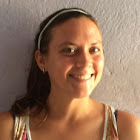 Manon and I also had the chance to hang out with some members of the Wayuu, the dominant indiginous group in the northeast of Colombia. They shared with us some traditions such as the traditional dress, face paintings, dance, and legends. Here is Manon displaying proudly her new make-up, and then me in the colorful garb. (I have videos of us attempting the dance, but they just don't want to load!)
Manon and I also had the chance to hang out with some members of the Wayuu, the dominant indiginous group in the northeast of Colombia. They shared with us some traditions such as the traditional dress, face paintings, dance, and legends. Here is Manon displaying proudly her new make-up, and then me in the colorful garb. (I have videos of us attempting the dance, but they just don't want to load!)
I thought their stories were the coolest part of everything that they shared with us. There was one story about the women spirits who live in the river and enter into your dreams as the person you most desire in the world. She seduces you to a point of intimacy, but if you are not careful and go to the river with her, she will drown you. There is another story about a large, cannabalistic woman who lives nearby the ranch where we were staying and who comes out every once in a while looking for prey. This story sort of reminded me of Paul Bunyan... although he was not a cannabal. I just thought they might be good company for each other, being lonely giants and all. The last story was about a species of people who only have one leg and the foot on the leg is on backwards, so when walking in the desert upon seeing the tracks the strange being is actually headed in the opposite direction then you would logically think. Apparently these species are vicious and impossible to kill, so of course there is a story about a man who did not believe this and set out to kill one. Obviously he did not succeed. Oh yeah! One more thing about these guys- when their eyes are closed that means they are awake, and when their eyes are open that means they are sleeping.
I don't know, sometimes I think the woman was just making these stories up as she talked, playing with our little gullible tourist-minds. I mean, I have no way of knowing if these really are the legends of the Wayuu or not, but I'm just going to trust her and keep away from hopping, apparently sleeping people with a backwards foot.

I put this on Megan's post too. Interesting fact learned from Wikipedia:
ReplyDeleteThe aboriginal inhabitants of the area were an ethnic group of arawak language, which remained free, defeating the spanish conquest. Their descendants, the wayuu people still inhabits the area. Cabo de La Vela ("Jepirra" in wayuunaiki language) is a sacred place to them, since they believe it is the place where the souls of all the deceased travel to rest with the ancestors, as the gate to afterlife.